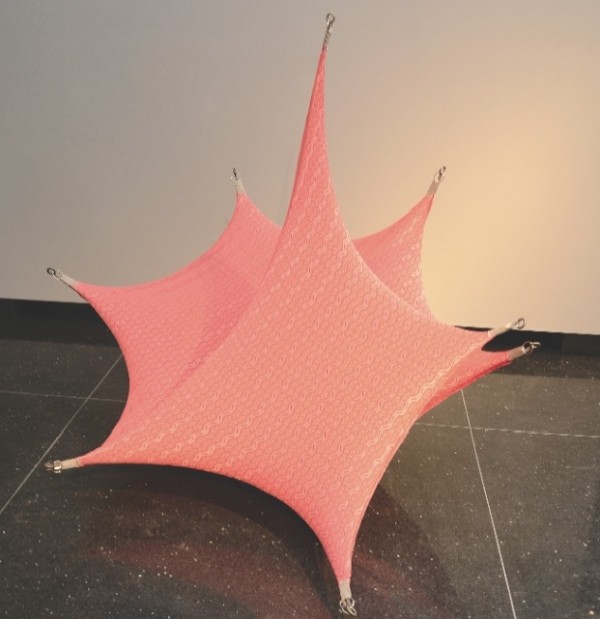
- A tent by Venessa Gromek
Earlier this year, the Central Utah Art Center lost its home of 20 years—evicted from its location in Ephraim, in Sanpete County, in a historical building that its founders had saved from demolition. The final show there—set to the tunes of the movie Footloose, screened as a comment on what CUAC’s board saw as a form of censorship by the city—was Aug. 18.
Now, CUAC has a new home in Salt Lake City. At its new digs at 175 E. 200 South, CUAC will host the exhibit After the End, celebrating the renewal of the organization at the new space, and life after Ephraim. The new exhibit carries on the work of the center, which received a prestigious grant from the Andy Warhol Foundation two years ago for bringing challenging, progressive artwork to Utah. Its new home perhaps provides less of a dramatic juxtaposition than its former rural location, but these are still works you might not see anywhere else in Utah.
Adam Bateman has taken the occasion of institutional “apocalypse” to curate a show that muses about the theme. In the press release, he says, “There is something essentially sublime about the apocalypse,” and by that he means something aesthetically transcendent as well as existentially transformative. “I think that the sublime is a transcendent moment where an individual becomes aware of her relationship to something much bigger, like the scale of a human life versus geologic time,” he says.
Bateman compares it to the feeling if one were to see God. “One would feel in awe and conscious of one’s temporal existence in contrast with the eternal nature of God, while feeling uniquely attached to God because of the personal nature of the experience. In the sublime, there is a duality of experience that encompasses both the awareness of one’s mortality and the awareness of one’s individual existence.
“I think the totality and finality of an apocalyptic event contains that same duality,” Bateman says. “This show explores how people aestheticize apocalypse.”
The artists in this show—all local residents at one point—could be exhibited anywhere in the world. Venessa Gromek, a BFA candidate in sculpture at Weber State, uses her experience in the outdoor industry to create tents that aren’t meant for shelter or survival, and seem more like totems. Jason Metcalf’s work is also currently showing at the Utah Museum of Contemporary Art, where his show ABRACADABRA deals with superstitions. Cara Despain, a former City Weekly contributor, integrates sound into her installations to create a subtle depth of sensory information. Czech-born Salt Laker Lenka Konopasek’s paintings and mixed-media works examine the personal nature of political conflict.
The work of Daniel Everett, a BYU associate professor, investigates ways the human-made environment has structured our experience. The paintings of Weber State professor Matthew Choberka articulate a sense of trauma. Salt Lake native Rebecca Campbell lives in Los Angeles, and has shown her oil paintings packed with bold brush strokes around the West, as well as Ameringer-Yohe Fine Art in New York and Art Basel. All these artists confront what it means to exist in that moment when contemplating the apocalyptic, and it’s a visually stunning show because of it.
As much as the eviction might have shaken Bateman’s faith in the support of art by government, his faith, or lack of, in art itself remains empowering: “I’m not sure I always have much faith in art’s ability to be transcendent. I hope it sometimes accomplishes that, but I really think that art is more of a reflection of our time as opposed to some sort of medicine, therapy or religion. I’m not sure it helps us cope or survive, but at least—and at its best—it reflects and criticizes whatever is happening.”
Bateman sees the role of CUAC as a “catalyst for growth in the critical mass of contemporary art in this state.” He often uses the term “critical mass” in describing art here, and there is a sense among him and others that we are approaching a threshold of talent, exposure and scale that will see the city gain stature in the art world.
CUAC might consider changing its name, but for now, Bateman has hopes of keeping a foothold in Ephraim. Bateman also hopes to stay at the 200 South site for at least a year, with the goal of eventually moving into a larger space in the same area. “As we continue to negotiate with Ephraim City and defend ourselves in court, we hope to come to a resolution that will allow us to maintain some kind of presence in Sanpete County as well as Salt Lake City.”
AFTER THE END
Central Utah Art Center
175 E. 200 South
435-283-5110
Dec. 22-Jan.14
Opening reception Dec. 22, 8-10 p.m.
Free
CUArtCenter.org